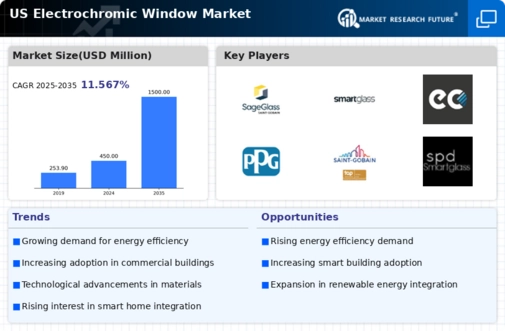Rising Construction Activities
The resurgence of construction activities in the US is a pivotal driver for the electrochromic window market. As urbanization accelerates, there is a growing demand for innovative building materials that enhance aesthetic appeal and functionality. Electrochromic windows, with their ability to adjust tint based on sunlight, are increasingly favored in modern architectural designs. The US construction industry is expected to reach a value of $1.8 trillion by 2026, with a notable portion allocated to energy-efficient technologies. This trend suggests a promising outlook for the electrochromic window market as builders and architects seek to incorporate advanced solutions into new projects.
Growing Environmental Awareness
The increasing awareness of environmental issues among consumers and businesses is driving the electrochromic window market. As sustainability becomes a priority, more entities are seeking solutions that reduce energy consumption and carbon footprints. Electrochromic windows offer a viable option by minimizing reliance on artificial lighting and HVAC systems, thus enhancing energy efficiency. In the US, the market for energy-efficient building materials is projected to grow at a CAGR of approximately 10% through 2027. This trend indicates a robust demand for products that align with eco-friendly practices, positioning the electrochromic window market favorably within the broader context of sustainable construction.
Regulatory Support for Energy Efficiency
Government regulations and incentives aimed at promoting energy efficiency are significantly impacting the electrochromic window market. Various federal and state initiatives encourage the adoption of energy-efficient technologies in residential and commercial buildings. For instance, tax credits and rebates for energy-efficient upgrades can enhance the attractiveness of electrochromic windows. The US Department of Energy has set ambitious goals for reducing energy consumption in buildings, which could lead to a projected increase in the market size of energy-efficient products, including electrochromic windows, by over 15% by 2026. This regulatory landscape fosters a conducive environment for market growth.
Technological Innovations in Manufacturing
Advancements in manufacturing technologies are propelling the electrochromic window market forward. Innovations such as improved materials and production techniques have led to enhanced performance and reduced costs of electrochromic windows. These developments make the technology more accessible to a broader range of consumers and businesses. The market is witnessing a shift towards more durable and efficient products, which could potentially increase market penetration. As manufacturing processes become more streamlined, the electrochromic window market may experience a growth rate of around 12% annually, reflecting the positive impact of these technological innovations.
Increased Focus on Smart Building Solutions
The growing trend towards smart building solutions is influencing the electrochromic window market. As buildings become more integrated with smart technologies, the demand for windows that can adapt to environmental conditions is rising. Electrochromic windows can be seamlessly integrated with building management systems, allowing for automated control of light and temperature. This integration not only enhances comfort but also contributes to energy savings. The smart building market in the US is projected to grow significantly, potentially reaching $100 billion by 2027, which bodes well for the electrochromic window market as it aligns with the broader shift towards intelligent infrastructure.


















Leave a Comment